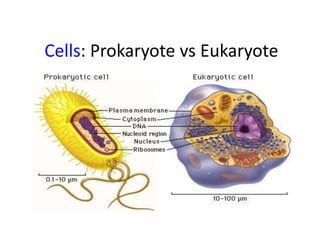
Prokaryote vs Eukaryote Cells: Key Differences Explained
- 1. Cells: Prokaryote vs Eukaryote
- 2. Cells have evolved two different architectures: • Prokaryote “style” • Eukaryote “style”
- 3. Prokaryotic cells were here first and for billions of years were the only form of life on Earth. All prokaryotic organisms are unicellular Eukaryotic cells appeared on earth long after prokaryotic cells but they are much more advanced. Eukaryotic organisms unlike prokaryotic can be unicellular or multicellular.
- 4. Characteristics of Prokaryotes • Prokaryotes are the simplest type of cell. • Oldest type of cell appeared about four billion years ago. • Prokaryotes are the largest group of organisms • Prokaryotes unicellular organisms that are found in all environments.
- 5. • Prokaryotes do not have a nuclear membrane. Their circular shaped genetic material dispersed throughout cytoplasm. • Prokaryotes do not have membrane-bound organelles. • Prokaryotes have a simple internal structure. • Prokaryotes are smaller in size when compared to Eukaryotes.
- 6. Shapes of Prokaryotes • Cocci = spherical (round) • Bacillus = (rod shaped) • Spirilla = helical (spiral)
- 8. Characteristics of eukaryotes • Eukaryotic cells appeared approximately one billion years ago • Eukaryotes are generally more advanced than prokaryotes • Nuclear membrane surrounds linear genetic material (DNA)
- 9. • Unlike prokaryotes, eukaryotes have several different parts. • Prokaryote’s organelles have coverings known as membranes. • Eukaryotes have a complex internal structure. • Eukaryotes are larger than prokaryotes in size .
- 11. Differences Prokaryotes • Organelles lack a membrane • Ribosomes are the only organelles • Genetic material floats in the cytoplasm (DNA and RNA) Eukaryotes • Organelles covered by a membrane • Multiple organelles including ribosomes • Membrane covered Genetic material
- 12. Prokaryotes • Circular DNA • Unicellular • Cells are smaller in size • Has larger number of organisms • Appeared 4 billion years ago Eukaryotes • Linear DNA • May be multicellular or unicellular • Cells are larger in size • Has smaller number of organisms • Appeared 1 billion years ago
- 13. Similarities • Both types of cells have cell membranes (outer covering of the cell) • Both types of cells have ribosomes • Both types of cells have DNA • Both types of cells have a liquid environment known as the cytoplasm
- 14. Prokaryote cells are smaller and simpler • Commonly known as bacteria • 10-100 microns in size • Single-celled (unicellular) or • Filamentous (strings of single cells)
- 15. These are prokaryote E. coli bacteria on the head of a steel pin.
- 16. Prokaryote cells are simply built (example: E. coli) • capsule: slimy outer coating • cell wall: tougher middle layer • cell membrane: delicate inner skin
- 17. • cytoplasm: inner liquid filling • DNA in one big loop • pilli: for sticking to things • flagella: for swimming • ribosomes: for building proteins Prokaryote cells are simply built (example: E. coli)
- 18. Prokaryote lifestyle • unicellular: all alone • colony: forms a film • filamentous: forms a chain of cells
- 19. Prokaryote Feeding • Photosynthetic: energy from sunlight • Disease-causing: feed on living things • Decomposers: feed on dead things
- 20. Eukaryotes are bigger and more complicated • Have organelles • Have chromosomes • can be multi-cellular • include animal and plant cells
- 21. Organelles are membrane-bound cell parts • Mini “organs” that have unique structures and functions • Located in cytoplasm
- 22. • Cell membrane – delicate lipid and protein skin around cytoplasm – found in all cells Cell Structures
- 23. • Nucleus – a membrane-bound sac evolved to store the cell’s chromosomes(DNA) – has pores: holes
- 24. • Nucleolus – inside nucleus – location of ribosome factory – made or RNA
- 25. • Mitochondrion – makes the cell’s energy – the more energy the cell needs, the more mitochondria it has
- 26. • Ribosomes – build proteins from amino acids in cytoplasm – may be free-floating, or – may be attached to ER – made of RNA
- 27. • Endoplasmic reticulum – may be smooth: builds lipids and carbohydrates – may be rough: stores proteins made by attached ribosomes
- 28. • Golgi Complex – takes in sacs of raw material from ER – sends out sacs containing finished cell products
- 29. • Lysosomes – sacs filled with digestive enzymes – digest worn out cell parts – digest food absorbed by cell
- 30. • Centrioles – pair of bundled tubes – organize cell division
- 31. Cytoskeleton • made of microtubules • found throughout cytoplasm • gives shape to cell & moves
- 32. Structures found in plant cells • Cell wall – very strong – made of cellulose – protects cell from rupturing – glued to other cells next door
- 33. • Vacuole – huge water-filled sac – keeps cell pressurized – stores starch
- 34. • Chloroplasts – filled with chlorophyll – turn solar energy into food energy
- 35. Difference between Animal & Plant Cell
- 36. Structure Animal cells Plant cells cell membrane Yes yes nucleus Yes yes nucleolus yes yes ribosomes yes yes ER yes yes Golgi yes yes centrioles yes no cell wall no yes mitochondria yes yes cholorplasts no yes One big vacuole no yes cytoskeleton yes Yes
- 37. Eukaryote cells can be multicellular • The whole cell can be specialized for one job • cells can work together as tissues • Tissues can work together as organs
- 38. Advantages of each kind of cell architecture Prokaryotes Eukaryotes simple and easy to grow can specialize fast reproduction Multi-cellularity all the same can build large bodies
